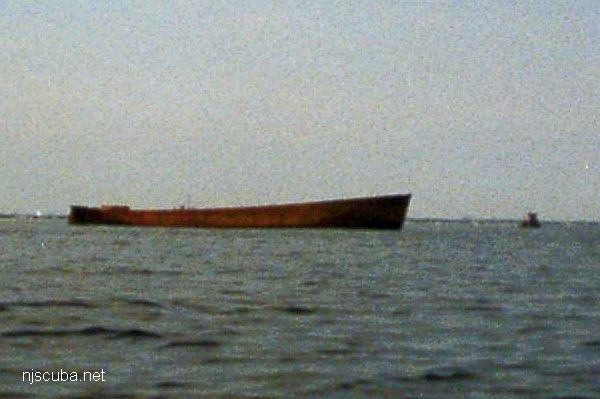Dykes

- Type:
- artificial reef, schooner barge, USA
( The small smokestack in the pictures is for an electrical generator. ) - Built:
- 1919, Union Shipbuilding, Baltimore MD USA
- Specs:
- ( 306 x 35 ft ) 2072 tons, 14 crew
- Sponsor:
- Modern Transportation Co.
- Sunk:
- July 1983 - Sea Girt Artificial Reef
- GPS:
- 40°06.964' -73°57.571'
- Depth:
- 65 ft

The Dykes was originally built to carry bauxite ( aluminum ore ) from British Guyana ( in South America ) for ALCOA. That didn't work out well, and she was soon sold to a coal-hauling firm, as most schooner barges were used. In 1935, the Dykes was sold again and converted to an unrigged sludge barge for New York City. ( see Coney Island, R.C. Mohawk. ) She continued in this service until she was retired in 1959. The Dykes was finally sunk by the state of New Jersey as an artificial reef in 1983. This actually predates the present Artificial Reef Program. The wreck lies slightly outside the official boundaries of the Sea Girt Artificial Reef.
The steel-hulled Dykes was one of the last and biggest five-masted schooners built. The wreck itself consists of a large area of iron ribs and hull plates, many of them a bright orange rust color. The bow and stern are somewhat intact, and even the hinges where the rudder was once attached are recognizable. In between, the ship has deteriorated. As the hull decayed, the sides splayed out, forming a much wider debris field than the original structure. There is still good relief against the clean sandy bottom, most of the structure averaging 4-6 ft in height.
Dykes is not listed in state records; nonetheless, it is one of the best reef sites out there.



The ribbing and hull plates form a maze of small compartments in some places, low overhanging ledges in others. The masts were cut down to stumps, some of which can still be found. Some of the peripheral wreckage lies at odd and unexpected angles to the main axis of the wreck. The best way to navigate is to follow the keel, which is identifiable by a small raised ridge along the top of it. This is like a highway from one end of the wreck to the other.
Many fish and a few small lobsters make their homes here, and it is even possible to get decent mussels from the higher spots. Later in the season, schools of Jacks and Scup swarm around the bow, while fluke and really big blackfish and Sea Bass can be found around the edges of the debris field and in the maze of small compartments in the center of the wreck.


The Dykes, minutes before sinking. Notice how her profile has been substantially altered from the photos above.
Lying as it does only 4 miles from the Manasquan River inlet, the Dykes makes a good second dive, with unusually good visibility and negligible current for such a close-in site. However, despite its closeness to shore, this is a very big wreck and it is easy to get lost ( especially in the dark, ) so a wreck reel is strongly advised.











Questions or Inquiries?
Just want to say Hello? Sign the .